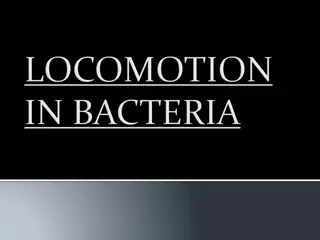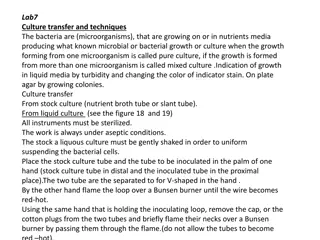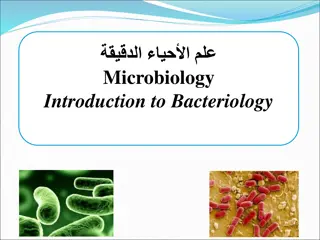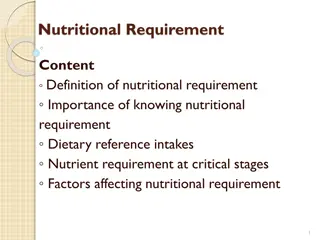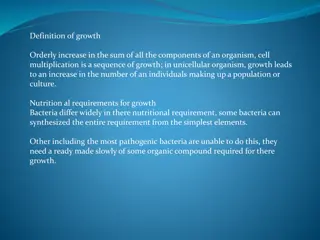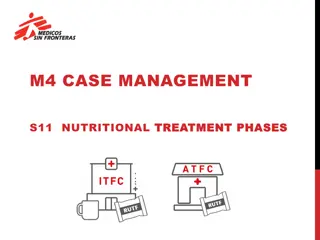Understanding Bacterial Growth and Nutritional Requirements
Bacterial growth involves processes like binary fission, exponential phase, and stationary phase. Factors influencing growth include nutrient availability, oxygen levels, and toxic waste accumulation. Lag phase precedes exponential growth, where cells prepare for division. Stationary phase occurs when growth rate equals death rate. Death phase results from unfavorable conditions. Microbial growth is essential for various studies and understanding their nutritional requirements is crucial for their cultivation.
Download Presentation

Please find below an Image/Link to download the presentation.
The content on the website is provided AS IS for your information and personal use only. It may not be sold, licensed, or shared on other websites without obtaining consent from the author. Download presentation by click this link. If you encounter any issues during the download, it is possible that the publisher has removed the file from their server.
E N D
Presentation Transcript
Bacterial growth and nutritional requirements
Binary fission 1.Prokaryote cells grow by increasing in cell number (as opposed to increasing in size). 2.Replication is by binary fission, the splitting of one cell into two 3.Therefore, bacterial populations increase by a factor of two (double) every generation time.
Microbial Growth Growth may be defined as an increase in cellular constituents. It leads to a rise in cell number when microorganisms reproduce by processes like budding or binary fission. In the latter, individual cells enlarge and divide to yield two progeny of approximately equal size. Growth also results when cells simply become longer or larger. If the microorganism is coenocytic that is, a multinucleate organism in which nuclear divisions are not accompanied by cell divisions growth results in an increase in cell size but not cell number
Lag Phase When microorganisms are introduced into fresh culture medium, usually no immediate increase in cell number occurs, and there- fore this period is called the lag phase. No cell division ------------no net increase in mass, (the cell is synthesizing new components). Why there is lag phase 1-The cells may be old and depleted of ATP, essential cofactors, and ribosomes; these must be synthesized before growth can begin. 2-The medium may be different from the one the microorganism was growing in previously. Here new enzymes would be needed to use different nutrients. Possibly the microorganisms have been injured and require time to recover. the cells retool, replicate their DNA, begin to increase in mass, and finally divide. Length of lag phase varies quite long if the inoculum is from an old culture or one that has been refrigerated. medium chemically different medium Short when a young, vigorously growing exponential phase culture is transferred to fresh medium of the same composition, the lag phase will be short or absent.
Exponential Phase microorganisms are growing and dividing at the maximal rate possible given their genetic potential, the nature of the medium, and the conditions under which they are growing. Their rate of growth is constant during the exponential phase; that is, the microorganisms are dividing and doubling in number at regular intervals. Because each individual divides at a slightly different moment, the growth curve rises smoothly rather than in discrete jumps . The population is most uniform in terms of chemical and physiological properties during this phase; therefore exponential phase cultures are usually used in biochemical and physiological studies. Stationary Phase usually is attained by bacteria at a population level of around 109cells per ml the total number of viable microorganisms remains constant because balance between cell division and cell death Why Microbial populations enter the stationary phase. 1-nutrient limitation; if an essential nutrient is severely depleted, population growth will slow. 2- Aerobic organisms often are limited by O2 availability. Oxygen is not very soluble and may be depleted so quickly that only the surface of a culture will have an O2 concentration adequate for growth. The cells beneath the surface will not be able to grow unless the culture is shaken or aerated in another way. 3- Population growth also may cease due to the accumulation of toxic waste products. Death Phase Detrimental environmental changes like nutrient deprivation and the buildup of toxic wastes lead to the decline in the number of viable cells
The Mathematics of Growth Growth rate studies contribute to basic physiological and ecological research and the solution of applied problems in industry. During the exponential phase each microorganism is dividing at constant intervals. Thus the population will double in number during a specific length of time called the generation time or doubling time. This situation can be illustrated with a simple example. Suppose that a culture tube is inoculated with one cell that divides every 20 minutes. The population will be 2 cells after 20 minutes, 4 cells after 40 minutes, and so forth. Because the population is doubling every generation, the increase in population is always 2n where n is the number of generations. The resulting population increase is exponential or logarithmic .
BACTERIAL GROWTH NUTRITIONAL REQUIREMENTS 1. Water - 70 to 80% of a bacterial cell is water 2. Carbon and energy source (may be same or different) Carbon source - CO 2 or organic molecules autotrophs - (lithotrophs)- can use CO 2 as the sole carbon source for all cellular organic molecules heterotrophs - (organotrophs)- require an organic molecule as the carbon source monosaccharides - glucose, galactose, fructose, ribose, etc. disaccharides - sucrose (E. coli can't use), lactose (S. typhimurium can't use) organic acids - succinate, lactate, acetate amino acids - glutamate, arginine alcohols - glycerol, ribitol fatty acids Energy source - light (photosynthesize), inorganic, or organic compounds photoautotrophs - grow with light and CO 2 (e.g., cyanobacteria) chemoautotrophs - oxidation of inorganic compounds (e.g., H 2 , S, H 2 S, Fe, NH 3 ); carbon from CO 2 photoheterotrophs - grow with light and organic carbon source (e.g., purple bacteria) chemoheterotrophs - use organic molecules for both carbon and energy source Most bacteria and all human pathogens are chemoheterotrophs
3. Nitrogen - 10% dry weight is N (proteins, nucleic acids) Inorganic source a. ammonia: NH 3 b. nitrogen (N 2 ) fixation - Azotobacter, Klebsiella, Rhizobium c. nitrate (NO 3 - ) or nitritre (NO 2 - ) Organic source amino acids (e.g., glutamate, glutamine, proline) 4. Inorganic ions Large amounts of: SO 42-(source of S: amino acids, coenzymes, proteins), PO 4 3-(NAD, ATP, nucleotides, etc.), K +(principal cation, cofactor for enzymes), Na + (some halophiles), Mg 2+(counter ion for anionic, polymers, e.g., ribosomal RNA, and cofactor, for enzymes), Fe 2+(heme, iron-sulfur proteins), Ca2+(gm+cell walls, lots in spores). Trace elements (micronutrients): Zn 2+, Mn2+, Mo 2+, Cu 2+,Co 2+,Se
5. Oxygen aerobe (strict) - requires O 2 anaerobe (strict) - killed by O 2 (lack superoxide dismutase, catalase). facultative anaerobe - grows with or without O 2 (respire or ferment). Uses it if it's there. aerotolerant anaerobe - grows with or without O 2 (ferment always) microaerophilic - grows best with low O 2 , can grow without 6. CO 2 Heterotrophs require CO 2 for some biosynthetic reactions: 7. Other growth factors Many heterotrophs (particularly pathogens) require additional organic growth factors, e. g., vitamins, amino acids, purine or pyrimidine bases, heme, etc.
Oxygen requirements Oxygen is a very reactive molecule and can affect cells in several ways. The effect of oxygen is often determined using thioglycollate broth, a special medium that contains a reducing agent (thioglycollate) that removes oxygen so that a gradient occurs within the tube. Obligately aerobic bacteria can obtain energy only through aerobic respiration and have to have oxygen available. Thus, they will grow only at the surface of thioglycollate broth. Obligately anaerobic bacteria die in the presence of oxygen and can only grow at the bottom of thioglycollate broth. Some anaerobes are so sensitive to oxygen that even thioglycollate broth is not anoxic enough to provide suitable anaerobic conditions. Microaerophiles require oxygen for growth but the 20% in air is too toxic. As a result, they grow near the top but beneath the surface of thioglycollate broth where the oxygen concentration is typically 4 10%. Facultative anaerobes can use oxygen for aerobic respiration but can switch to fermentative metabolism in the absence of oxygen. As a result, they will grow throughout thioglycollate broth. (Heavier growth at top.) Aerotolerant anaerobes are anaerobic bacteria that can grow in the presence of air. (Not shown in diagram.)
PHYSICAL REQUIREMENTS 1. Temperature - Bacteria can grow from -5 to ~100 C: thermophiles - >50 o C psychrophiles - 4 o to 20 o C mesophiles - 20 o to 45 C (pathogens) Ranges and optimum temperatures for growth. Optimum usually close to that of the natural habitat. 2. pH range and optimum again - different species can grow between 2 and 10. E. coli range is 4.5 to 8 Acidophiles have their growth optimum between pH 0 and 5.5; mesophiles, between pH 5.5 and 8.0; and alkalophiles prefer the pH range of 8.5 to 11.5. 3. Ionic strength or salt tolerance bacteria don't tolerate well a very low ionic strength medium like water. halophilic bacteria can tolerate and even require high salt, e.g., 30% NaCl 4. Oxidation-reduction potential (E h ) strict anaerobes can't tolerate oxygen, require reducing agents in the medium. important for bacterial growth in wounds. Initial growth by aerobic bacteria uses up the oxygen, which causes a progressive decrease in E h , and wound infection then becomes possible by anaerobic pathogens such as Clostridium perfringens (gas gangrene).







